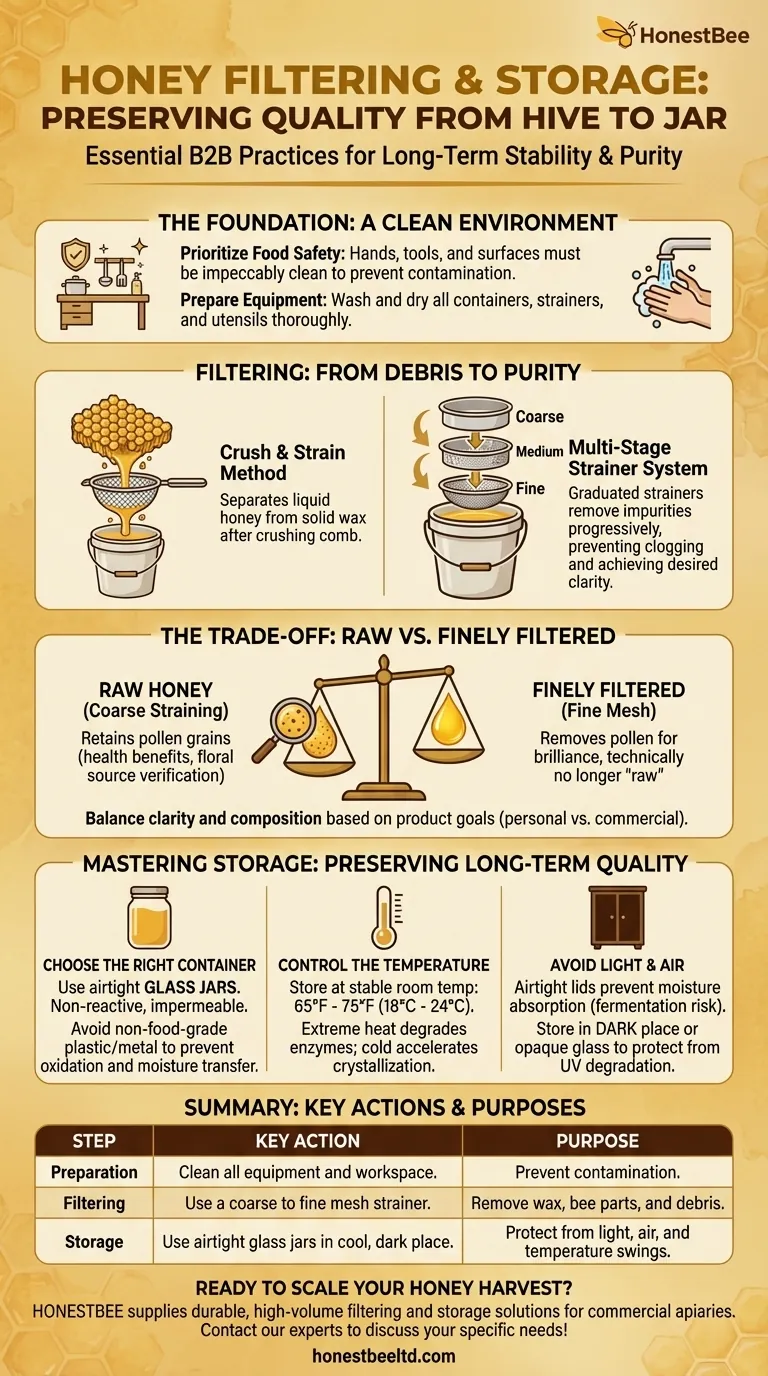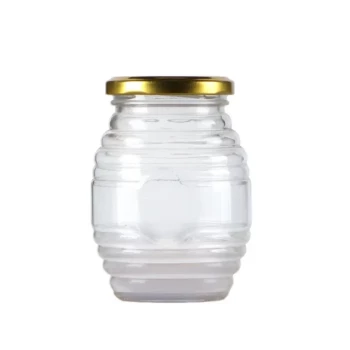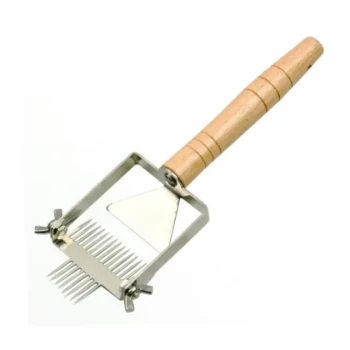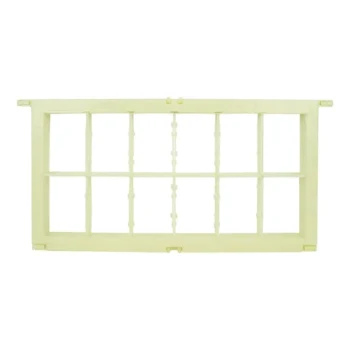Proper filtering and storage are the final, crucial steps to preserve the quality of your harvested honey. The process involves straining the honey through a fine mesh to remove physical impurities like wax and bee parts. Once filtered, the honey must be stored in clean, airtight, food-safe containers and kept in a cool, dark place to prevent degradation and maintain its flavor for years.
The goal of filtering and storage is not just to clean the honey, but to protect it from its three primary enemies: contamination, temperature fluctuations, and light. Mastering these principles ensures your honey remains stable, flavorful, and safe for consumption.

The Foundation: A Clean Environment
Before you begin filtering or bottling, you must ensure every surface and piece of equipment is impeccably clean. Honey is a food product, and preventing contamination is your first and most important responsibility.
Prioritize Food Safety
Your workspace, hands, and tools must be clean. Tie back long hair and avoid any activities like smoking that could introduce foreign contaminants into the honey.
Prepare Your Equipment
All containers, strainers, and utensils that will come into contact with the honey should be thoroughly washed and dried. This simple step prevents the introduction of bacteria or unwanted flavors.
Filtering Your Honey: From Debris to Purity
Filtering is the mechanical process of removing physical debris left over from the extraction process. The goal is to produce a clean, pure product without altering the honey itself.
The Goal of Filtering
The primary purpose of filtering is to remove visible impurities. This includes wax cappings, bee parts, wood splinters from the frames, and any other debris that may have fallen into the honey during extraction.
The Crush and Strain Method
For beekeepers using a "crush and strain" extraction, filtering is built into the process. After crushing the comb, the resulting mix of honey and wax is poured through a strainer or fine mesh cloth to separate the liquid honey from the solid wax.
Using a Multi-Stage Strainer
A highly effective method is to use a set of graduated strainers. These systems typically fit over a five-gallon bucket and consist of multiple layers, moving from a coarse mesh on top to a very fine mesh at the bottom.
This progressive filtering is efficient, as the coarse strainer catches the large pieces of wax, preventing the fine strainer from clogging too quickly.
Mastering Honey Storage: Preserving Long-Term Quality
Once filtered, proper storage is essential to protect the honey from chemical and physical changes. Temperature, light, and air are the key factors you must control.
Choose the Right Container
Glass jars with tight-fitting lids are the ideal choice. Glass is non-reactive and impermeable, ensuring nothing leaches into the honey.
Avoid non-food-grade plastic or metal containers. Certain metals can react with honey, causing oxidation and imparting a metallic taste, while some plastics can allow moisture transfer.
Control the Temperature
Store your honey at a stable room temperature, ideally between 65°F and 75°F (18°C to 24°C). A pantry or cupboard is perfect.
Extreme heat can degrade the honey's delicate enzymes and aromas, while cold temperatures will accelerate crystallization.
Avoid Light and Air Exposure
Airtight lids are non-negotiable. Honey is hygroscopic, meaning it will absorb moisture from the air. Excess moisture can raise the water content above 18%, creating a risk of fermentation.
Direct sunlight also degrades honey quality through UV radiation. Storing jars in a dark place or using opaque or colored glass containers offers the best protection.
Understanding the Trade-offs: Raw vs. Finely Filtered
The extent to which you filter your honey involves a key trade-off between clarity and composition. There is no single "correct" answer; it depends on your goal.
The Role of Pollen
Raw, unfiltered honey contains microscopic pollen grains, which many consumers value for their potential health benefits and for verifying the honey's floral source.
Balancing Clarity and Composition
Very fine filters (measured in microns) can remove these pollen grains, resulting in a brilliantly clear product but one that is technically no longer "raw." Coarse strainers will remove debris but leave the valuable pollen intact.
Decide what you want to produce. For personal use, a simple coarse straining is often sufficient. For honey intended for sale or competition, a clearer, more refined appearance may be desired.
Making the Right Choice for Your Goal
Your approach to filtering and storage should align directly with your intended use for the honey.
- If your primary focus is producing "raw" honey for personal use: Use a simple, single-stage coarse strainer to remove large debris while retaining all the natural pollen.
- If your primary focus is creating crystal-clear honey for gifts or sale: Employ a multi-stage filtering system, moving from a coarse to a fine mesh to achieve maximum clarity.
- If your primary focus is long-term preservation: Prioritize airtight glass containers stored in a cool, dark pantry, regardless of your filtering method.
By controlling these factors, you act as the final guardian of your honey's quality, ensuring every drop is as perfect as it was in the hive.
Summary Table:
| Step | Key Action | Purpose |
|---|---|---|
| 1. Preparation | Clean all equipment and workspace. | Prevent contamination. |
| 2. Filtering | Use a coarse to fine mesh strainer. | Remove wax, bee parts, and debris. |
| 3. Storage | Use airtight glass jars in a cool, dark place. | Protect from light, air, and temperature swings. |
Ready to scale your honey harvest with professional-grade equipment? For commercial apiaries and beekeeping equipment distributors, HONESTBEE supplies durable, high-volume honey filtering and storage solutions through wholesale-focused operations. Our equipment is designed to help you maintain the highest quality standards efficiently. Contact our experts today to discuss your specific needs and get a quote!
Visual Guide

Related Products
- Stainless Steel Triangle Support Honey Strainer and Filters
- Honey Concentrating and Filtering Dehumidifier Machine 2T Capacity for Honey
- Electric 8 Frame Honey Spinner Extractor Equipment for Beekeeping
- Easy Use Manual Stainless Steel Honey Press for Honey Comb
- Stainless Steel Manual 8 Frame Radial Honey Extractor Machine for Beehives
People Also Ask
- What is the easiest way to strain honey? A Simple Guide for Hobbyist Beekeepers
- Why is filtering important in honey processing, and what equipment is used? A Guide to Quality & Efficiency
- What are the benefits of using a honey strainer for beekeepers? Achieve Clean, High-Quality Honey Efficiently
- What methods are used for straining honey? Choose the Right Method for Your Scale
- What are the benefits of using a honey filtering machine? Boost Purity, Efficiency & Market Appeal



















